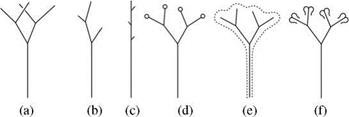![]() As mentioned earlier, we are mainly concerned with cormophytes, land plants consisting of roots, shoot axes, and foliage. Starting at the shoot, the branch develops through vertical growth. It can bud, branch out, form a bloom or die off. The division of the branch is the fundamental element of each branching structure.
As mentioned earlier, we are mainly concerned with cormophytes, land plants consisting of roots, shoot axes, and foliage. Starting at the shoot, the branch develops through vertical growth. It can bud, branch out, form a bloom or die off. The division of the branch is the fundamental element of each branching structure.
The origin of branching systems and megaphylls can be explained through the Telome Theory. Although based on some former hypotheses, it was largely developed by W. Zimmermann between 1930 and 1965 [236]. The theory has steadily gained favor. The basic unit in the telome concept is the telome, described as that part of the branching system between the last dichotomy and the distant end of the branch. The structure of plants is explained illustrating different developments of fork formations (stem branching). In this hypothesis, the organs of today’s differentiated plants emerge through application of some fundamental procedures. The theory applies to both the macroscopic branching within a branch structure, and to the microscopic structure of leaves.
The Telome Theory originated from an evolutionary viewpoint: the first plants characteristically consisted of a very simple structure and gradually refined themselves in the evolutionary process. An example of a still-existing terrestrial, simple plant is the whisk fern (Psylotum), which branches regularly in several stages and thereby resembles certain ancient vascular plants (urteloms). In its appearance, the psylotum also has a strong resemblance to the first land plants, which today are extinct.
|

The first telome thus develops in the context of an evolutionary change into very diverse organs, which are part of the various plant forms of our time, by overtopping, reduction, planation, webbing or bending. In Fig. 2.1 the forked shoot can be seen with the five different shapes.
■ Overtopping
Out of a primarily equal branching, a main axis can develop, which then predominantly produces further branching. This is called recursive poly – podial branching. Thus, a differentiation in the main axis and assimilating side axes takes place, which over time also leads to branching of the axis and leaves [72]. Overtopping occurs in most tree species. Leaves display similar patterns through the differentiation in the dominant midrib and subordinate veins.
Chapter 2 ■ Reduction
Plants
The process of overtopping can be further intensified by reduction of the subsequent systems. In many trees extreme overtopping and reductions can lead to almost straight trunks with comparatively small branches.
■ Planation
Planation is the transformation of a primarily three-dimensional into a twodimensional branching. This happens for instance with the leaf veins, which are arranged flat in a web-type manner.
■ Webbing
A planar arrangement of the branching structure often results in a multifarious, webbed growth. This way a leaf evolves, which is also significant for the differentiation of the branch axis. However, such complex webbed growth can also develop with a spatially arranged telome. If such webbing occurs in telomes, a relatively thick trunk can develop that consists of several so-called vascular bundles, and which is especially stable.
■ Bending
If the ends of the branch axis are curved or bent, then this usually serves the alignment of propagation organs that in this way are arranged on the leaf’s lower surface.
For the construction and differentiation of the telome – in particular with regard to webbing – a subordinate, thus exogenous process is necessary for the implementation as an algorithm, allowing formed branching structures to interact in parallel. Within the rule-based plant production in Chap. 5, this is modeled through so-called context-sensitive systems. The procedural methods described in Chap. 4 also partly offer such mechanisms. Mostly, however, one tries to avoid such interacting processes, since they are usually computing-time and memory-intensive, and they also considerably increase the complexity of the algorithms.
For computer graphics, the telome theory is interesting in so far as it explains a number of plant growth forms through variations of the basic forking process, meaning that the procedure can be described, theoretically as well as algorithmically, through parameterization of a single production method. This kind of procedure is covered in Chap. 4.
It must be noted, however, that there are different hypotheses, such as the Ena – tion Theory [72], which explains the arrangement of leaves as swellings of the bark fabric. Although it is most certainly an elegant explanation, the Telome Theory should therefore only be consulted for its description of branching structures.



